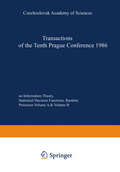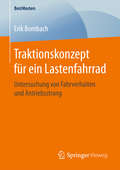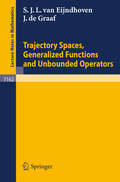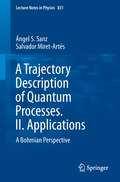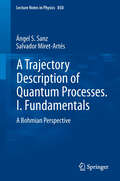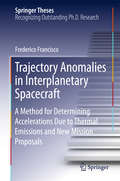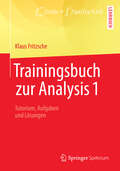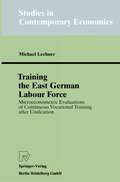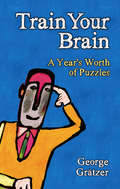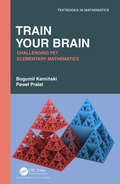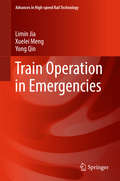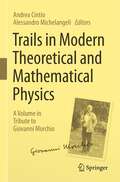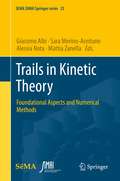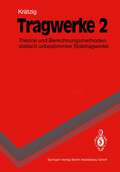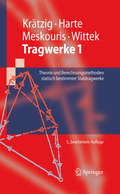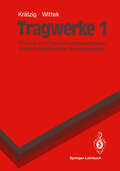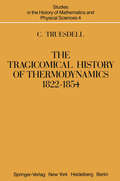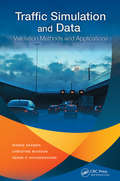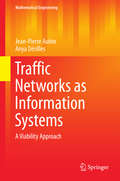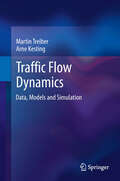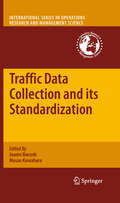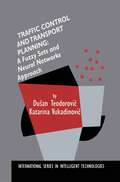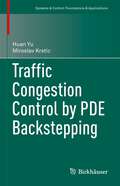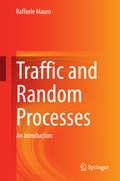- Table View
- List View
Transactions of the Tenth Prague Conference on Information Theory, Statistical Decision Functions, Random Processes: held at Prague, from July 7 to 11, 1986 (Transactions of the Prague Conferences on Information Theory #10A-B)
by J. A. VísekTraktionskonzept für ein Lastenfahrrad: Untersuchung von Fahrverhalten und Antriebsstrang
by Erik BombachErik Bombach untersucht anhand einer Simulink-Modellierung des Gesamtsystems Lastenpedelec verschiedene Antriebskonzepte und vergleicht diese primär an der Position des Motors miteinander. Zudem wird das Potential von Dualspeichern, Rekuperation und prädiktiver Motorregelung bewertet. Dabei wird die kinetische Simulation der Fahrdynamik sowie die Energetik verschiedener Lastfälle eingebunden. Der Autor beurteilt ebenfalls die Tauglichkeit eines Mehrmotorantriebes, welcher bis heute keine Anwendung in der Praxis findet. Dazu stellt er drei Betriebsstrategien vor, die bestimmen, wann welcher Motor wie viel Leistung erbringen muss. Seine Auswertung ergab, dass die optimale Motorposition vom Anwendungsgebiet des Lastenpedelecs abhängt. Das hergeleitete Modell hat durch seinen modularen Aufbau eine hohe Anpassungsfähigkeit und ist in den verschiedensten Anwendungen nutzbar.
Trajectory Spaces, Generalized Functions and Unbounded Operators (Lecture Notes in Mathematics #1162)
by Stephanus van Eijndhoven Johannes de GraafA Trajectory Description of Quantum Processes. II. Applications: A Bohmian Perspective (Lecture Notes in Physics #831)
by Ángel S. Sanz Salvador Miret-ArtésTrajectory-based formalisms are an intuitively appealing way of describing quantum processes because they allow the use of "classical" concepts. Beginning as an introductory level suitable for students, this two-volume monograph presents (1) the fundamentals and (2) the applications of the trajectory description of basic quantum processes. This second volume is focussed on simple and basic applications of quantum processes such as interference and diffraction of wave packets, tunneling, diffusion and bound-state and scattering problems. The corresponding analysis is carried out within the Bohmian framework. By stressing its interpretational aspects, the book leads the reader to an alternative and complementary way to better understand the underlying quantum dynamics.
A Trajectory Description of Quantum Processes. I. Fundamentals: A Bohmian Perspective (Lecture Notes in Physics #850)
by Ángel S. Sanz Salvador Miret-ArtésTrajectory-based formalisms are an intuitively appealing way of describing quantum processes because they allow the use of "classical" concepts. Beginning at an introductory level suitable for students, this two-volume monograph presents (1) the fundamentals and (2) the applications of the trajectory description of basic quantum processes. This first volume is focussed on the classical and quantum background necessary to understand the fundamentals of Bohmian mechanics, which can be considered the main topic of this work. Extensions of the formalism to the fields of open quantum systems and to optics are also proposed and discussed.
Trajectory Anomalies in Interplanetary Spacecraft: A Method for Determining Accelerations Due to Thermal Emissions and New Mission Proposals (Springer Theses)
by Frederico FranciscoThis thesis presents fundamental work that explains two mysteries concerning the trajectory of interplanetary spacecraft. For the first problem, the so-called Pioneer anomaly, a wholly new and innovative method was developed for computing all contributions to the acceleration due to onboard thermal sources. Through a careful analysis of all parts of the spacecraft Pioneer 10 and 11, the application of this methodology has yielded the observed anomalous acceleration. This marks a major achievement, given that this problem remained unsolved for more than a decade.For the second anomaly, the flyby anomaly, a tiny glitch in the velocity of spacecraft that perform gravity assisting maneuvers on Earth, no definitive answer is put forward; however a quite promising strategy for examining the problem is provided and a new mission is proposed. The proposal largely consists in using the Galileo Navigational Satellite System to track approaching spacecraft, and in considering a small test body that approaches Earth from a highly elliptic trajectory.
Trainingsbuch zur Analysis 1: Tutorium, Aufgaben und Lösungen
by Klaus FritzscheDie Mathematik gilt als schwierig, und ganz besonders die Analysis 1 wird von Studienanfängern als Stolperstein empfunden. Dabei bräuchten die meisten nur etwas mehr Anleitung und vor allem viel Übung, kurz, ein intensives Training. Dieses Buch bietet ein solches Training an.Der Aufbau orientiert sich am Grundkurs Analysis 1 des Autors, aber dank ausführlicher Literaturhinweise mit inhaltlichen Zuordnungen kann das Training Analysis 1 als Begleitung zu jedem gängigen Lehrbuch und jeder Analysisvorlesung erfolgreich eingesetzt werden.Auf eine Zusammenfassung der Theorie folgen in jedem Abschnitt Tutorien mit ausführlichen Erklärungen zu ausgewählten, wichtigen Themen. Danach werden zahlreiche durchgerechnete Beispiele und schließlich eine Reihe von Aufgaben mit mehr oder weniger ausführlichen Lösungshinweisen angeboten. Unterstützt wird das Ganze durch viele Illustrationen, und ein Anhang enthält ausführlich durchgerechnete Musterlösungen zu allen Aufgaben.
Training the East German Labour Force: Microeconometric Evaluations of continuous Vocational Training after Unification (Studies in Contemporary Economics)
by Michael LechnerAfter unification large amounts of money were spent to retrain the East Germany labour force in order to ease the transition to the new market economy. This book uses microeconometric methods and individual data to evaluate the impact of these training programmes on the participants' labour market situation. It discusses the appropriate evaluation methodology as well as the effectiveness of the actual programmes for the individual participants. The empirical results suggest that the public sector sponsored training programmes were fairly ineffective. In contrast, the training organized and paid by the enterprises caused considerable earnings growings.
Train Your Brain: A Year's Worth of Puzzles
by George GratzerMany people start the day with physical exercise but few seem to be so concerned with exercising the most human of organs-the brain. This book provides you with entertaining and challenging mental exercises for every week of the year. Whether you are a high school student eager to sharpen your brain, or someone older who would like to retain your m
Train Your Brain: Challenging Yet Elementary Mathematics (Textbooks in Mathematics)
by Bogumil Kaminski Pawel PralatThis accessible book helps readers to see the bigger picture of advanced mathematics. The book contains carefully selected, challenging problems in an easy-to-follow, step-by-step process. Neither prior preparation nor any mathematical sophistication is required. The authors guide the reader to “train their brain” to think and express themselves in a rigorous, mathematical way, and to extract facts, analyze the problem, and identify main challenges. A firm foundation in a diverse range of topics is presented. Moreover, the authors show how to draw appropriate, true conclusions. Computer support is used to better intuition into discussed problems. The book is designed for self-study. It can be used to bridge the gap between introductory calculus/linear algebra courses and more advanced courses offered at universities. It improves the ability to read, write, and think in a rigorous, mature mathematical fashion. The reader will develop a deeper understanding in preparation to succeed in more advanced course work. Features•The authors employ a six-step process: 1.SOURCE2.PROBLEM3.THEORY4.SOLUTION5.REMARK6.EXERCISES •An Appendix introduces programming in Julia This book is also suitable for high school students that are interested in competing in math competitions or simply for people of all ages and backgrounds who want to expand their knowledge and to challenge themselves with interesting questions.
Train Your Brain: Challenging Yet Elementary Mathematics (Textbooks in Mathematics)
by Bogumil Kaminski Pawel PralatThis accessible book helps readers to see the bigger picture of advanced mathematics. The book contains carefully selected, challenging problems in an easy-to-follow, step-by-step process. Neither prior preparation nor any mathematical sophistication is required. The authors guide the reader to “train their brain” to think and express themselves in a rigorous, mathematical way, and to extract facts, analyze the problem, and identify main challenges. A firm foundation in a diverse range of topics is presented. Moreover, the authors show how to draw appropriate, true conclusions. Computer support is used to better intuition into discussed problems. The book is designed for self-study. It can be used to bridge the gap between introductory calculus/linear algebra courses and more advanced courses offered at universities. It improves the ability to read, write, and think in a rigorous, mature mathematical fashion. The reader will develop a deeper understanding in preparation to succeed in more advanced course work. Features•The authors employ a six-step process: 1.SOURCE2.PROBLEM3.THEORY4.SOLUTION5.REMARK6.EXERCISES •An Appendix introduces programming in Julia This book is also suitable for high school students that are interested in competing in math competitions or simply for people of all ages and backgrounds who want to expand their knowledge and to challenge themselves with interesting questions.
Train Operation in Emergencies (Advances in High-speed Rail Technology)
by Limin Jia Xuelei Meng Yong QinThis book presents the latest findings on train operation theories and methods in the context of emergencies. It examines and assesses a range of aspects—including the definition of a railway emergency, transport organization modes in emergencies, calculating railway transport capacity in emergencies, line planning in emergencies, train re-pathing in emergencies and train re-scheduling in emergencies—that are urgently needed in the railway transportation field, which faces the serious challenge of dealing with emergencies worldwide. The book highlights the latest research results in an integrated and systematic way, and the methodology presented is oriented on real-world problems, allowing it to be used not only directly in railway operational management, but also as the point of departure for further applications or theoretical research. As such, the book will be of considerable interest to graduate students and researchers in the field of traffic and transportation engineering.>
Trails in Modern Theoretical and Mathematical Physics: A Volume in Tribute to Giovanni Morchio
by Andrea Cintio Alessandro MichelangeliThis book celebrates the life and work of the late Giovanni Morchio (1944–2021). It features scientific and anecdotal contributions written by his former colleagues, co-authors, and students, as well as senior scientists who were active witnesses to the dramatic advances in physics and in mathematics that took place during his 50-year-long career. The volume begins with a biographical introduction, detailing Giovanni Morchio’s life and his role as a physicist, mathematician, teacher, and scientist. The core of the book covers a vast spectrum of ideas, reflecting Dr Morchio’s scientific interests. Each chapter develops a specific topic of modern research, ranging from quantum mechanics and quantum field theory to additional themes such as the connection between general relativity and Newtonian gravitation. Every contribution provides a historical retrospective, a survey of advances, an outlook of future perspectives and challenges, and an updated bibliography. The last part collects the authors’ recollections of their professional and personal interactions with Dr Morchio, in recognition of his deep achievements, his exceptional pedagogical qualities, and his praiseworthy social and pro bono commitment. Authored by physicists of international calibre covering a broad range of subjects, the book will be a valuable reference for researchers and students of theoretical and mathematical physics.
Trails in Kinetic Theory: Foundational Aspects and Numerical Methods (SEMA SIMAI Springer Series #25)
by Giacomo Albi Sara Merino-Aceituno Alessia Nota Mattia ZanellaIn recent decades, kinetic theory - originally developed as a field of mathematical physics - has emerged as one of the most prominent fields of modern mathematics. In recent years, there has been an explosion of applications of kinetic theory to other areas of research, such as biology and social sciences. This book collects lecture notes and recent advances in the field of kinetic theory of lecturers and speakers of the School “Trails in Kinetic Theory: Foundational Aspects and Numerical Methods”, hosted at Hausdorff Institute for Mathematics (HIM) of Bonn, Germany, 2019, during the Junior Trimester Program “Kinetic Theory”. Focusing on fundamental questions in both theoretical and numerical aspects, it also presents a broad view of related problems in socioeconomic sciences, pedestrian dynamics and traffic flow management.
Tragwerke 2: Theorie und Berechnungsmethoden statisch unbestimmter Stabtragwerke (Springer-Lehrbuch)
by Wilfried B. KrätzigTragwerke 1: Theorie und Berechnungsmethoden statisch bestimmter Stabtragwerke (Springer-Lehrbuch)
by Wilfried B. Krätzig Reinhard Harte Konstantin Meskouris Udo WittekDas Standardlehrwerk beschäftigt sich mit der Ermittlung der Kraft- und Verformungszustände von allgemeinen, statisch bestimmten Stabtragwerken sowie von wichtigen Tragwerkstypen. Dabei vereint es die Grundlagen der technischen Mechanik mit der konzeptionellen, tragwerksspezifischen Problemlösung. Dargestellt werden die fundamentalen Abstraktions- und Arbeitsmethoden, die wesentlichen analytischen Berechnungsmethoden werden an typischen Beispielen erläutert. Die Neuauflage berücksichtigt aktuelle Normen und neue Bezeichnungen.
Tragwerke 1: Theorie und Berechnungsmethoden statisch bestimmter Stabtragwerke (Springer-Lehrbuch)
by Wilfried B. Krätzig Udo WittekGott bietet uns alle Güter dieser Welt um den Preis der Arbeit. Leonardo da Vinci, 1452-1519 Das vorliegende Lehrbuch zur Statik statisch bestimmter Stabtragwerke ist als vorlesungsbegleitende Lektüre der Lehrveranstaltungen gleichen Namens an der Ruhr-Universität Bochum und der Universität Kaiserslautern konzipiert worden. Seine Erstausgabe entstand 1971; das vorliegende Manuskript stellt eine dritte, nunmehr grundlegende Neubearbeitung dar. Ein wichtiger Aufgabenbereich aller konstruktiv gestaltenden Bauingenieure besteht darin, die Kraft- und Weggrößenzustände von Tragwerken als Grundlage ihrer sicheren Dimensionierung hinreichend genau zu bestimmen. In der Statik der Tragwerke werden daher Hypothesen und Erkenntnisse der Technischen Mecha nik, dargestellt in der Sprache der Mathematik, auf dieses Ziel hin orientiert. Ausgehend von diesen Grundkonzepten führt deshalb das Buch in fundamentale Denk- und Arbeitsmethoden von Festigkeitsberechnungen ein und entwickelt gleichzeitig die wichtigsten Analyseverfahren für statisch bestimmte Stabtragwer ke. Deren Anwendungen werden in einer Vielzahl von Beispielen erläutert, wobei wichtige Rechenschritte und getroffene Idealisierungen besonders hervorgehoben werden. Hauptzweck der sorgfältig dokumentierten Beispiele für den Leser sollte jedoch das Eindenken in das Tragverhalten einfacher Strukturen sein.
The Tragicomical History of Thermodynamics, 1822–1854 (Studies in the History of Mathematics and Physical Sciences #4)
by C. TruesdellTraffic Simulation and Data: Validation Methods and Applications
by Winnie Daamen Christine Buisson Serge P. HoogendoornA single source of information for researchers and professionals, Traffic Simulation and Data: Validation Methods and Applications offers a complete overview of traffic data collection, state estimation, calibration and validation for traffic modelling and simulation. It derives from the Multitude Project-a European Cost Action project that incorpo
Traffic Networks as Information Systems: A Viability Approach (Mathematical Engineering)
by Jean-Pierre Aubin Anya DésillesThis authored monograph covers a viability to approach to traffic management by advising to vehicles circulated on the network the velocity they should follow for satisfying global traffic conditions;. It presents an investigation of three structural innovations: The objective is to broadcast at each instant and at each position the advised celerity to vehicles, which could be read by auxiliary speedometers or used by cruise control devices. Namely, 1. Construct regulation feedback providing at each time and position advised velocities (celerities) for minimizing congestion or other requirements.2. Taking into account traffic constraints of different type, the first one being to remain on the roads, to stop at junctions, etc. 3. Use information provided by the probe vehicles equipped with GPS to the traffic regulator;4. Use other global traffic measures of vehicles provided by different types of sensors; These results are based on convex analysis, intertemporal optimization and viability theory as mathematical tools as well as viability algorithms on the computing side, instead of conventional techniques such as partial differential equations and their resolution by finite difference or finite elements algorithms. The target audience primarily covers researchers and mathematically oriented engineers but the book may also be beneficial for graduate students.
Traffic Flow Dynamics: Data, Models and Simulation
by Martin Treiber Arne KestingThis textbook provides a comprehensive and instructive coverage of vehicular traffic flow dynamics and modeling. It makes this fascinating interdisciplinary topic, which to date was only documented in parts by specialized monographs, accessible to a broad readership. Numerous figures and problems with solutions help the reader to quickly understand and practice the presented concepts. This book is targeted at students of physics and traffic engineering and, more generally, also at students and professionals in computer science, mathematics, and interdisciplinary topics. It also offers material for project work in programming and simulation at college and university level.The main part, after presenting different categories of traffic data, is devoted to a mathematical description of the dynamics of traffic flow, covering macroscopic models which describe traffic in terms of density, as well as microscopic many-particle models in which each particle corresponds to a vehicle and its driver. Focus chapters on traffic instabilities and model calibration/validation present these topics in a novel and systematic way. Finally, the theoretical framework is shown at work in selected applications such as traffic-state and travel-time estimation, intelligent transportation systems, traffic operations management, and a detailed physics-based model for fuel consumption and emissions.
Traffic Data Collection and its Standardization (International Series in Operations Research & Management Science #144)
by Jaume Barceló Masao KuwaharaA nice night of October 2007, in Beijing, during the XV World Conference on ITS a number of colleagues met informally for a dinner party that spontaneously became a vivid discussion on the importance of traffic data for all types of p- poses. Researchers can hardly do any progress in modeling, developing, and te- ing theories without suitable data, and what practitioners can do in real life is limited not only by technology but also by the availability of the required data. Quite frequently, the data and not the technologies are what determine how far we can go. Any discussion about traffic data leads in a natural way to a discussion on the variety of traffic data sources, formats, levels of aggregation, accuracies, and so on. Consequently, we moved to talk on the initiative that Kuwahara had undertaken in his traffic laboratory at the University of Tokyo, known as the International Traffic Data Base, and thus smoothly but inexorably we came to agree that it would be convenient to organize a workshop to continue our discussion at a more formal level, share our points of view with other colleagues, listen what they had to say and, if possible, d- seminate the findings in our professional and academic communities.
Traffic Control and Transport Planning: A Fuzzy Sets and Neural Networks Approach (International Series in Intelligent Technologies #13)
by Dusan Teodorovic Katarina VukadinovicWhen solving real-life engineering problems, linguistic information is often encountered that is frequently hard to quantify using "classical" mathematical techniques. This linguistic information represents subjective knowledge. Through the assumptions made by the analyst when forming the mathematical model, the linguistic information is often ignored. On the other hand, a wide range of traffic and transportation engineering parameters are characterized by uncertainty, subjectivity, imprecision, and ambiguity. Human operators, dispatchers, drivers, and passengers use this subjective knowledge or linguistic information on a daily basis when making decisions. Decisions about route choice, mode of transportation, most suitable departure time, or dispatching trucks are made by drivers, passengers, or dispatchers. In each case the decision maker is a human. The environment in which a human expert (human controller) makes decisions is most often complex, making it difficult to formulate a suitable mathematical model. Thus, the development of fuzzy logic systems seems justified in such situations. In certain situations we accept linguistic information much more easily than numerical information. In the same vein, we are perfectly capable of accepting approximate numerical values and making decisions based on them. In a great number of cases we use approximate numerical values exclusively. It should be emphasized that the subjective estimates of different traffic parameters differs from dispatcher to dispatcher, driver to driver, and passenger to passenger.
Traffic Congestion Control by PDE Backstepping (Systems & Control: Foundations & Applications)
by Huan Yu Miroslav KrsticThis monograph explores the design of controllers that suppress oscillations and instabilities in congested traffic flow using PDE backstepping methods. The first part of the text is concerned with basic backstepping control of freeway traffic using the Aw-Rascle-Zhang (ARZ) second-order PDE model. It begins by illustrating a basic control problem – suppressing traffic with stop-and-go oscillations downstream of ramp metering – before turning to the more challenging case for traffic upstream of ramp metering. The authors demonstrate how to design state observers for the purpose of stabilization using output-feedback control. Experimental traffic data are then used to calibrate the ARZ model and validate the boundary observer design. Because large uncertainties may arise in traffic models, adaptive control and reinforcement learning methods are also explored in detail. Part II then extends the conventional ARZ model utilized until this point in order to address more complex traffic conditions: multi-lane traffic, multi-class traffic, networks of freeway segments, and driver use of routing apps. The final chapters demonstrate the use of the Lighthill-Whitham-Richards (LWR) first-order PDE model to regulate congestion in traffic flows and to optimize flow through a bottleneck. In order to make the text self-contained, an introduction to the PDE backstepping method for systems of coupled first-order hyperbolic PDEs is included. Traffic Congestion Control by PDE Backstepping is ideal for control theorists working on control of systems modeled by PDEs and for traffic engineers and applied scientists working on unsteady traffic flows. It will also be a valuable resource for researchers interested in boundary control of coupled systems of first-order hyperbolic PDEs.
Traffic and Random Processes: An Introduction
by Raffaele MauroThis book deals in a basic and systematic manner with the fundamentals of random function theory and looks at some aspects related to arrival, vehicle headway and operational speed processes at the same time. The work serves as a useful practical and educational tool and aims at providing stimulus and motivation to investigate issues of such a strong applicative interest. It has a clearly discursive and concise structure, in which numerical examples are given to clarify the applications of the suggested theoretical model. Some statistical characterizations are fully developed in order to illustrate the peculiarities of specific modeling approaches; finally, there is a useful bibliography for in-depth thematic analysis.
